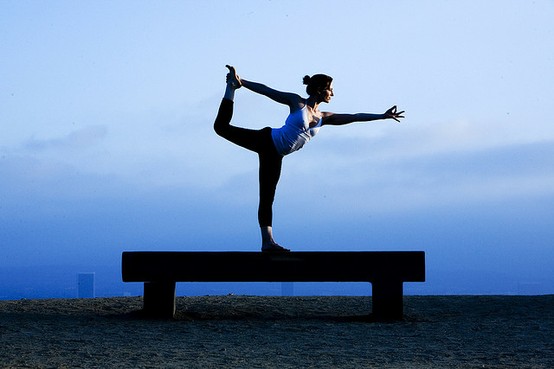By Jessica Innes.
De-stress and Stretch Out – two things dancers need a good dose of!
The inspiring choreographer Mia Michaels articulately pointed out that “when your spirit dances your body will follow.” This is sometimes easier said than done in an image conscious world of auditions, injuries and physical exertion. Yoga has been practiced since 3000BC and is based on the Sanskrit word meaning to “join, unite and attach” referring to the connection of body and mind. The result is an undisrupted ability to bare our souls as dancers with confidence, intuition and freedom of movement.
There are many different forms of Yoga and all offer unique benefits, however the results of Ashtanga Vinyasa Yoga in regards to a dancers flexibility, strength and balance are quite remarkable. Ashtanga yoga begins with a series of Sun Salutations as a warm up. This allows blood to flow through the body, clearing toxins and warming the core and extremities. Following this, a series of “Asanas” [poses] are performed both standing and seated. The standing poses focus on balance, concentration, alignment and stamina and when done correctly can result in working up quite a sweat! As dancers we always need to work on these core strengths. The seated poses allow for deep stretching in order to improve flexibility, as well as clarity of mind. Dance and Yoga have an evident relationship with one another as one of the standing Asanas is named “Natarajasana” meaning “Lord of the Dance.”
In addition to the physical aspects, deep breathing exercises called “Pranayama” allow dancers to look inwards and release tension. No matter what your spiritual beliefs, taking a moment to sit, breathe and relax can only be good for you. Breathing exercises don’t have to be a spiritual act, unless you intend them to be.
Here’s a simple breathing exercise you can try at home:
- Sit comfortable with your legs crossed. Close your eyes and rest your hands on your knees, palms facing upwards.
- Take a natural breath that allows your lungs to fill comfortably and then slowly exhale.
- Continue to do this as you count down your breaths from 50 to 0. Each time envision more of your tensions and worries disappearing from your body with each exhalation.
- If your mind wanders to sounds around you or other thoughts, calmly bring it back to your centre and focus on your breath. Notice how your breath feels on your top lip or how your diaphragm expands with each inhalation.
- When you reach 0, enjoy the feeling of serenity that you have attained before slowly opening your eyes.
As with any form of physical exercise it’s important to remember to work at your own level and not to exceed your own physical limitations. Yoga is designed to gently stretch the body; therefore moving slowly in and out of poses is essential. It is also imperative to be honest with yourself and never push a stretch to the point of being painful. You should feel the tension of the stretch gradually dissipate as your body eases into it. The more regularly you take Yoga, the quicker you will see improvements in your strength and flexibility.
Relaxing to many of us means sitting in front of the T.V. or reading a book, however next time you want to wind down, take your mind and body on a holiday and try a Yoga class in your area.
Top photo: The “Lord of the Dance” pose















